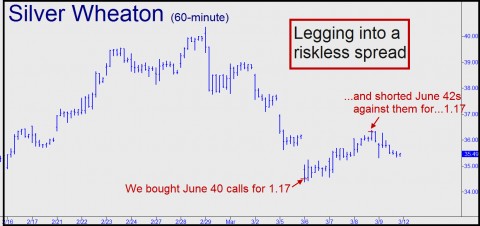Rick’s Picks occasionally serves up “softball” trades geared to relative novices who have never fooled around with stock options, let alone made money with them. The goal each time is to help subscribers make enough to pay for a year’s subscription to the service ($350, or click here for a free trial). Last week, we bid fair to put them on a winning track with a trade in Silver Wheaton designed to risk no more than literal pocket change. We did so in two steps: 1) buying June 40 call options for 1.17 when the underlying stock fell to within pennies of a correction target at 34.53 we’d identified earlier; then, 2) two days later, with the stock in a powerful rally, short-selling June 42 calls against the ones we’d bought for the same price. The net result was a vertical bull spread that cannot lose money no matter what the underlying stock does but which will produce a gain of as much as $200 per spread if Silver Wheaton is trading above $40 come mid-June.
Not bad odds, right? It’s like getting 15-to-1 on a horse to finish in-the-money, but also getting a money-back guarantee if the nag fails to place or show. Notice, however, that a profit on this trade is still contingent on a moderate rally between now and mid-June from a current price of around $36. If Silver Wheaton should fail to move above $40 over the next 90 days, however, the trade would ultimately produce neither a profit nor a loss – would in fact expire with a value of zero, or exactly what we “paid” for it. In the interim, unless SLW falls dramatically, we can always sell the vertical spread for more than zero. (It settled on Friday at 0.45 cents, yielding a theoretical gain on the position thus far of $90). This gambit should give you an idea of how very difficult it is to profit from “directional” option trades where one simply gets long or short based on a bullish or bearish hunch. With this trade, we are making a bullish bet on Silver Wheaton, but with no penalty if we are wrong – the only way to go, as far as we’re concerned.
40 Years, No Winners
We’ve been trading stock options for nearly 40 years, 12 of them as a market maker on the Pacific Exchange, and have never met a single person who has profited over time from buying puts or calls. In fact, the game is rigged so that only net sellers of puts and calls are likely to win consistently. We say “rigged” because margin requirements effectively prohibit the retail customers from selling “naked” puts and calls like the pros. The very term “naked” selling is invariably used by the news media – ignorantly – to suggest that it is a tactic of the reckless and foolhardy. To the contrary, naked sellers have much better odds of winning than the rubes on other side of the trades who buy puts and calls. In fact, statistically speaking, the latter are almost guaranteed to lose. And while some retail customers think they are beating the odds by doing covered writes, which entails selling call options against stock they own, that is a very tough game too, since a large move up or down in the underlying stock can wipe out a year’s worth of cumulative “yield” in mere hours.
To be sure, sellers of straddles, ratio spreads and other premium-rich combinations of puts and calls are all but guaranteed to experience a day when their positions explode to devastating effect. The best traders will survive to fight another day. As for the rest of us, it is better to take the long way around, doing trades in a series of steps, each of which is geared toward further reducing risk. If you have never had a winning trade with options or are skeptical that it can even be done, click here and give us a free try.
***
(If you’d like to have these commentaries delivered free each day to your e-mail box, click here.)


Fallingman, thanks for taking the time to respond. My post was nothing more than stating the obvious. Trading really is about one’s comfort level. Myself, I generally choose “deep-in-the-money” options. If one has the margin ability the other conservative route would have been sell the 35-40 puts when SLW hit your target….. Congrats on your stellar trading record.